What do you think?
Rate this book


331 pages, Paperback
First published January 1, 1995
For all that, the definite integral yet expresses a number. As a result, area undergoes an inevitable contraction, the quantity (or quality) vanishing in favor of the number that describes it, the whole of something, all that space, the Pedernales, those pecan trees, canceled in favor of a symbol, the lush particularity of this place, these trees, that swollen creek, demoted and then dismissed.
Writing in 1734, Bishop Berkeley wasted no time in attacking the very idea of infinitesimals. If they were greater than zero, the definition of instantaneous velocity would not define anything instantaneous, and if they were zero, the definition of instantaneous velocity would not define anything like speed.